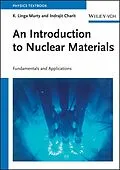In diesem Buch geht es um Einsatzmöglichkeiten verschiedener Materialien in der Kernenergietechnik. Nach einem allgemeinen Überblick über Aufbau und Funktion von Kernreaktoren werden die verschiedenen Systeme einzeln besprochen.
Die letzten Kapitel befassen sich mit Spezialthemen wie Reaktoren für die Raumfahrt und Fusionsreaktoren. Die Autoren legen viel Wert darauf, Struktur-Eigenschafts-Beziehungen herauszustellen und naturwissenschaftliche Prinzipien aus vielen Disziplinen zu erfassen. Jedes Kapitel wird durch eine Zusammenfassung, Literaturhinweise und Übungsaufgaben abgeschlossen. Kenndaten, die man für Anwendungen in der Praxis braucht, stellt ein Anhang übersichtlich zusammen.
Autorentext
K. Linga Murty has been on the faculty of the Nuclear Engineering department at North Carolina State University since 1981 and has been teaching courses in Nuclear Materials. He received his Ph.D. degree in Applied Physics (Materials) from Cornell University (USA) in 1970. Dr. Murty is the recipient of numerous awards including the American Nuclear Society Mishima Award (1993) and the Metcalfe Medal (1963). He is a fellow of ASM-International, ANS and IIM and has authored or coauthored more than 290 technical papers.
Indrajit Charit has been on the faculty of the Chemical and Materials Engineering department at the University of Idaho since 2007. He serves both Materials Science and Engineering and Nuclear Engineering programs. He received his Ph.D. degree in Metallurgical Engineering from the University of Missouri-Rolla (USA) in 2004. His research has been supported by the US Department of Energy's Nuclear Energy University Programs, Idaho National Laboratory and Center for Advanced Energy Studies.
He has published about 60 technical papers.
Klappentext
Covering both fundamental and advanced aspects in an accessible way, this textbook begins with an overview of nuclear reactor systems, helping readers to familiarize themselves with the varied designs. Then the readers are introduced to different possibilities for materials applications in the various sections of nuclear energy systems. Materials selection and life prediction methodologies for nuclear reactors are also presented in relation to creep, corrosion and other degradation mechanisms. An appendix compiles useful property data relevant for nuclear reactor applications.
Throughout the book, there is a thorough coverage of various materials science principles, such as physical and mechanical metallurgy, defects and diffusion and radiation effects on materials, with serious efforts made to establish structure-property correlations wherever possible. With its emphasis on the latest developments and outstanding problems in the field, this is both a valuable introduction and a ready reference for beginners and experienced practitioners alike.
From the contents:
- Overview of Nuclear Reactor Systems and Materials Selection Bases
- Fundamental Nature of Materials
- Fundamentals of Radiation Damage
- Dislocation Theories
- Properties of Materials
- Radiation Effects on Materials
- Nuclear Fuels
Please go to the book's catalogue entry on www.wiley-vch.de for a collection of additional problems.
Inhalt
Preface XV
1 Overview of Nuclear Reactor Systems and Fundamentals 1
1.1 Introduction 1
1.2 Types of Nuclear Energy 2
1.2.1 Nuclear Fission Energy 2
1.2.2 Nuclear Fusion Energy 2
1.2.3 Radioisotopic Energy 3
1.3 Neutron Classification 3
1.4 Neutron Sources 3
1.5 Interactions of Neutrons with Matter 3
1.5.1 Fission Chain Reaction 5
1.6 Definition of Neutron Flux and Fluence 6
1.7 Neutron Cross Section 7
1.7.1 Reactor Flux Spectrum 10
1.8 Types of Reactors 11
1.8.1 A Simple Reactor Design 11
1.8.2 Examples of Nuclear Reactors 12
1.8.2.1 Generation-I Reactors 13
1.8.2.2 Generation-II Reactors 15
1.8.2.3 Generation-III and IIIþ Reactors 22
1.8.2.4 Generation-IV Reactors 25
1.9 Materials Selection Criteria 28
1.9.1 General Considerations 31
1.9.1.1 General Mechanical Properties 31
1.9.1.2 Fabricability 32
1.9.1.3 Dimensional Stability 32
1.9.1.4 Corrosion Resistance 32
1.9.1.5 Design 32
1.9.1.6 Heat Transfer Properties 32
1.9.1.7 Availability and Cost 33
1.9.2 Special Considerations 33
1.9.2.1 Neutronic Properties 33
1.9.2.2 Susceptibility to Induced Radioactivity 33
1.9.2.3 Radiation Stability 35
1.9.3 Application of Materials Selection Criteria to Reactor Components 35
1.9.3.1 Structural/Fuel Cladding Materials 36
1.9.3.2 Moderators and Reflectors 36
1.9.3.3 Control Materials 36
1.9.3.4 Coolants 36
1.9.3.5 Shielding Materials 37
1.10 Summary 37
Appendix 1.A 37
Additional Reading Materials 40
2 Fundamental Nature of Materials 43
2.1 Crystal Structure 43
2.1.1 Unit Cell 45
2.1.2 Crystal Structures in Metals 47
2.1.2.1 Body-Centered Cubic (BCC) Crystal Structure 47
2.1.2.2 Face-Centered Cubic (FCC) Crystal Structure 49
2.1.2.3 Hexagonal Close-Packed (HCP) Crystal Structure 49
2.1.3 Close Packing Geometry 52
2.1.4 Polymorphism 53
2.1.5 Miller Indices for Denoting Crystallographic Planes and Directions 54
2.1.5.1 MillerBravais Indices for Hexagonal Close-Packed Crystals 57
2.1.6 Interstitial Sites in Common Crystal Structures 59
2.1.7 Crystal Structure of Carbon: Diamond and Graphite 60
2.1.8 Crystal Structure in Ceramics 62
2.1.8.1 Rock Salt Structure 63
2.1.8.2 CsCl Structure 64
2.1.8.3 Fluorite Structure 65
2.1.8.4 Zincblende Structure 66
2.1.8.5 Corundum Structure 66
2.1.9 Summary 69
2.2 Crystal Defects 69
2.2.1 Point Defects 70
2.2.1.1 Point Defects in Metals/Alloys 70
2.2.1.2 Point Defects in Ionic Crystals 77
2.2.2 Line Defects 79
2.2.3 Surface Defects 84
2.2.3.1 Grain Boundaries 84
2.2.3.2 Twin Boundaries 86
2.2.3.3 Stacking Faults 87
2.2.3.4 Other Boundaries 88
2.2.4 Volume Defects 88
2.2.5 Summary 88
2.3 Diffusion 89
2.3.1 Phenomenological Theories of Diffusion 90
2.3.1.1 Fick's First Law 90
2.3.1.2 Fick's Second Law 91
2.3.2 Atomic Theories of Diffusion 95
2.3.3 Atomic Diffusion Mechanisms 97
2.3.4 Diffusion as a Thermally Activated Process 101
2.3.5 Diffusion in Multicomponent Systems 105
2.3.6 Diffusion in Different Microstructural Paths 106
2.3.6.1 Grain Boundary Diffusion 106
2.3.6.2 Dislocation Core Diffusion 108
2.3.6.3 Surface Diffusion 108
2.3.7 Summary 108
Bibliography 110
3 Fundamentals of Radiation Damage 111
3.1 Displacement Threshold 114
3.2 Radiation Damage Models 118
3.3 Summary 125
Biblio...
